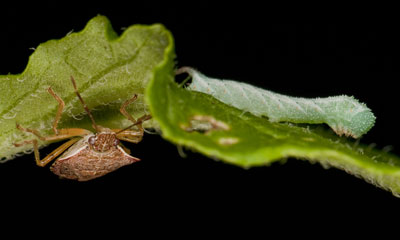Prey pays price to elude predators
By Krishna Ramanujan

When the threat of predators lurks, prey often eat less to avoid being out in the open and vulnerable to attack.
But a new study of tobacco hornworm caterpillars (Manduca sexta) and stink bugs (Podisus maculiventris) that feed on them finds that when threatened, these caterpillars do feed up to 40 percent less, yet they still develop faster and gain the same amount of weight as unthreatened caterpillars.
By doing so, they quickly become too big to be eaten. This allows young caterpillars to avoid a fundamental conflict for many organisms -- a choice between growing big or defending themselves against predators. Other studies have shown that tadpoles employ a similar strategy to escape predators by increasing their rate of development into frogs and leaving the environment quickly, but they pay the price of being small thereafter.
The study, published July 9 in the Proceedings of the National Academy of Sciences, describes how in the first few days of being threatened, the caterpillars became more efficient at extracting nitrogen from tomato plants they ate, and the fat content in their bodies increased.
"Even though the mass of threatened caterpillars was the same [as unthreatened caterpillars], they are fundamentally different creatures, and they are made of more lipids and less sugars," said Jennifer Thaler, a Cornell associate professor of insect ecology and the paper's lead author.
At the same time, Thaler and colleagues suspected there would be costs to the quick growth and heightened efficiency in digesting food. "There's no free lunch," Thaler added.
After nine days, the threatened caterpillars ate more than unthreatened caterpillars, but they processed their food with about 35 percent less efficiency than the control caterpillars. The researchers speculate that even though the threatened caterpillars are still vulnerable to predation, they may be forced to eat more to maintain their weight as the mechanism that allowed them to process their food more efficiently no longer functions. "They may have to eat more to keep up, otherwise they would grow more slowly," Thaler said. Still, more research is needed to better understand why their food processing efficiency declines at the end, she added.
"When we think about the major ecological factors that structure ecological communities, predation is one of the key forces," said Thaler. "So, we know predation is important, but we have little idea how it is influencing individuals. The definition of a predator is that it eats prey, but this ignores the fact that the mere presence of predators, regardless of whether they actually eat a caterpillar, causes the changes documented in the prey. We didn't realize the surviving caterpillars would be completely different."
In the study, the researchers set up small field cages, with three tomato plants and six second instar caterpillars, two to three days after hatching. (Instars refer to the different stages of development between hatching and the time of pupation.) Also, they added a stink bug, a predator that feeds on plants and crops, but also eats soft-bodied caterpillars in the spring after mating. The stink bugs' beaks poke the caterpillars and drain their fluids. To keep the caterpillars alive in the experiment, the beaks were snipped to allow the bugs to threaten and stress the caterpillars but not kill them.
After three days, the researchers measured how much of the tomato was eaten and weighed the caterpillars.
In the lab, the researchers started with caterpillars in their second instar with clipped stink bug predators, but kept them together for nine days, switching them to a new tomato plant every three days, to test the longer term effects of predation.
Paper cones were placed around the stems of the plants to collect the insects' waste (frass) to analyze its carbon and nitrogen content, and at the end of the experiments, the caterpillar bodies were frozen and analyzed for proteins, carbohydrates and sugars.
For each experiment, controls were also established.
Co-authors include Scott McArt, a graduate student in Thaler's lab, and Ian Kaplan, an assistant professor of insect ecology at Purdue University.
The study was funded by the U.S. Department of Agriculture.
Media Contact
Get Cornell news delivered right to your inbox.
Subscribe